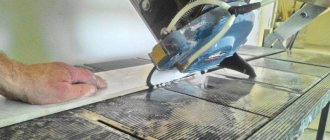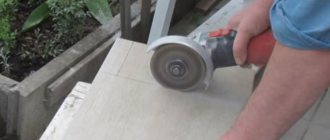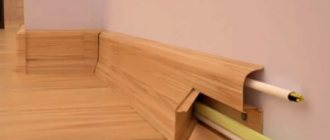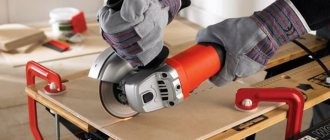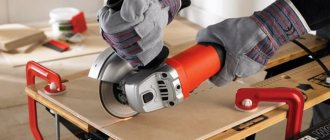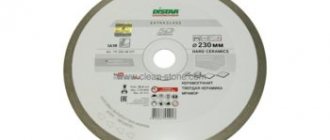Important points of the process
Essentially, paving stone cutting is the processing of durable concrete products of varying thicknesses. As a result of this procedure, elements of the required shapes and sizes are obtained. Moreover, their edges should be even and neat. It is possible to cut paving slabs in different ways: figuredly, across, longitudinally, diagonally. It is important to remember that concrete has a high density. It is achieved thanks to the peculiarities of its production: granite crushed stone is added to the composition, and the vibrocompression method is used. Therefore, all procedures should be carried out with a special tool, and the accuracy and correctness of such actions should be observed:
- Mark the tiles.
- Using the chosen method, cut the product.
- Carefully process the cuts.
The volume of all work, as well as their complexity, largely depends on the desired pattern and the initial shape of the paving stones. Typically, square or rectangular products are cut crosswise (according to pre-made markings). To create multi-colored patterns from tiles with complex shapes, much more force is required. The corner cut, which ensures the insertion of elements into a single structure, is the most difficult to perform. It can only be done with a hacksaw.
Attention! Regardless of the cutting method used, you should definitely use personal protective equipment when making cuts.
Without cutting the paving stones, it is almost impossible to lay out a complex pattern on the site Source trotuar.biz
What to consider during the cutting process
Cutting paving slabs, in essence, consists of processing a concrete product with a thickness of 2 to 8 centimeters in such a way as to ultimately obtain an element of the desired size and shape, without damaging it and making neat edges. You can cut tiles in different directions: crosswise or lengthwise, diagonally or curly.
We must not forget that concrete has a fairly dense structure due to the peculiarities of manufacturing tiles using the vibration pressing method and the introduction of crushed granite stone into the material. Therefore, all work must be carried out with a special tool, accurately and correctly.
The main stages of cutting tiles:
- Careful marking of the product
- Cutting by selected method
- Accurate processing of completed cuts
The complexity of the cutting work and its volume depend on the pattern being created and the shape of the tile itself. Rectangular and square elements are simply cut crosswise according to the markings. But when creating patterns from tiles of complex shapes and different colors, you will need to apply some effort, because here you need to achieve maximum clarity of the cut.
The most difficult is considered to be an angular cut, performed for the purpose of inserting parts into the overall structure. Such cuts are made exclusively with a hacksaw for metal. Regardless of the cutting method chosen, be sure to take care of personal protective equipment.
Security measures
Before you start sawing paving slabs (by any method), it is important to ensure reliable protection for the worker: this will help prevent possible injury. In the process of cutting paving stones, you must strictly adhere to the following rules:
- All work must be carried out in protective equipment, which includes a respirator, goggles, and protective clothing made of thick fabric. This applies most of all to cases where the cutting procedure involves the generation of a huge amount of dust.
- It is advisable to use special headphones that will protect against excessively loud noise.
- When using the selected tool, it is important to comply with the basic requirements for its operation: check the functionality of any mechanisms before starting work; change consumables on time; Avoid using improperly functioning devices; Do not place your fingers near rotating parts; Always use extreme caution when using power tools.
Each individual method of cutting paving stones involves its own set of rules. Therefore, it is extremely important to think through the sequence of all actions in advance and study the instructions for the devices that need to be used for such work.
In the process of cutting paving slabs, too much dust is generated: this requires the mandatory use of protective equipment Source i.ytimg.com
Cutting Features
Before cutting paving slabs, you need to carefully prepare. This refers to markings on individual concrete elements and the cutting area. For the latter, it is recommended to set aside an area away from other building materials, previously laid coverings, and all kinds of buildings.
Attention! The dust generated when cutting tiles is not easily swept away; it tends to eat into materials and spoil their color.
To ensure quality sawing of paving stones, you first need to take accurate measurements. As a rule, about ten percent of the margin is added to the obtained numbers. If necessary, the edges can then be processed to remove excess.
The tiles should be cut exactly along the pre-designated line. In this case, you should not put excessive pressure on the material, since the product may break into random parts or slip out of your hands.
Advice! If sawing with a grinder is difficult, the paving stones can be lightly sprinkled with regular sand. But since the latter can increase the sliding of the tool, it is important to be extremely careful in such situations.
When cutting paving slabs, you should not press too hard, as this may cause them to break into random pieces or slip out of your hands. Source i2.wp.com
Some nuances of the process
First you need to take care of protective equipment. When working with an angle grinder, when cutting, an unlimited amount of dust is released, so you will need a respirator and safety glasses to protect your eyes from dust.
First you need to take care of protective equipment. When working with an angle grinder, when cutting, an unlimited amount of dust is released, so you will need a respirator and safety glasses to protect your eyes from dust.
It's great if you also use headphones to protect yourself from loud noise. The materials from which work clothes are made should be quite dense.
The most important point. This is an exercise in caution. The diamond blade of the grinder spins very quickly, so you need to cut more carefully and carefully, and be careful with your fingers.
Having taken care of the equipment, you can start working.
Developing the process is not easy, because when you come to a masonry site where cutting tiles is required, get down to business right away.
Firstly, choose a tile that, in your opinion, is quite strong. Otherwise it might just fall apart.
Apply clear cutting stripes, painstakingly measuring the desired shape.
It is necessary to cut strictly along the drawn mowing strip, because paving slabs are usually small in size and shape, this will not be difficult to do. With all this, you cannot put too much pressure on the paving slabs
, so you can let it go.
If the cutting process is difficult, then you can use ordinary masonry sand to sprinkle the paving stones, but not too much, because this can add additional slip to the grinding machine, which is quite unsafe.
Necessary tool
To prepare the required size pieces of paving stones, you should stock up on special mechanisms. This is especially true when it is planned to develop a huge area, which means that elements will need to be cut in significant quantities.
To cut paving slabs you need to prepare:
- grinder with a set of diamond discs;
- guillotine knife or circular saw;
- chisel;
- hammer;
- file;
- hacksaw for metal;
- sandpaper;
- ruler;
- roulette;
- pencil.
Usually, the above tools are enough to properly cut the tiles and lay out the desired pattern on the area.
The saw for cutting Eibenstock paving slabs operates in dry mode and is equipped with a connector for connecting a vacuum cleaner, so during its use the workplace always remains clean Source promtovari.com.ua
Preparatory work
Even before cutting paving slabs with a grinder or any other suitable device, a number of measures should be taken:
- Find a free place, remote from the warehouse of building materials and buildings.
- Perform the necessary measurements, calculations, and markings of paving stones. It is worth noting that the latter can be done in advance only when laying simple-shaped concrete products. When a complex pattern is created, all designations are applied to the material for sawing when fitting the elements to one another on the site. Additionally, it is important to take into account the optimal technological gap (about 4 mm). It guarantees easy installation of each paving stone in its proper place, eliminating the need to close cracks and hammer in tiles.
- Check the functionality of the equipment, the presence of the required number of replacement parts. Check the functionality of the equipment, the presence of the required number of replacement parts. Check the functionality of the equipment, the presence of the required number of replacement parts. Check the functionality of the equipment, the presence of the required number of replacement parts. Check the functionality of the equipment, the presence of the required number of replacement parts. Check the functionality of the equipment and the availability of the required number of replacement parts.
In addition, do not forget to prepare protective equipment: gloves, goggles, work clothes, a respirator.
If paving slabs are laid out in the form of a complex pattern, then the tiles are cut during the work process Source msc-plitka.ru
Processing pieces
Regardless of the cutting method, the edges of lumber or chipped tiles will be uneven. This can cause the entire coating to appear. Therefore, it is necessary to complete the cutting process by processing the slices. There are several ways to eliminate defects:
- For small uneven areas you can use a sander or sandpaper, in some cases it is recommended to use a file;
- Large defects are best removed with a hacksaw or chips using a chisel.
Paving slabs are considered a durable but fragile material. Incorrect cutting can not only complicate the job of tiling the area, but also increase financial costs, since you will have to mask cracks and throw away damaged tiles.
Source
The question of how to cut paving slabs is relevant for all those who are involved in home improvement, creating garden or walking paths and installing various types of coverings from this material. It is almost impossible to lay tiles without cutting - there will still be areas where it is necessary to install a section of a smaller or different shape, especially when it comes to shaped tiles.
In many ways, the shape of the tile affects the difficulty of cutting: marking and cutting rectangle and rectangle than wave, hexagon, Z-profile, etc. The paving process typically uses certain patterns and designs. It is formed, requiring careful adjustment of the elements to size. In addition, you need to be able to properly process the cut edges of the tiles so that the coating is neat and aesthetically pleasing.
Tools for cutting tiles are used in different ways, the choice depends on the skill of the master, the type of tile, conditions and characteristics of the work. But first of all, it is necessary to study all existing technologies.
READ How to remove a gear from a screwdriver motor shaft
Cutting methods
Regardless of the chosen method of sawing paving stones, it is important to carry out all work using proper equipment, strictly observing safety regulations. Before you start sawing a durable tile product, it should be securely fixed. Often, a powerful grinder or guillotine is used to cut tiles. But with a minimum amount of work, it is permissible to use a hacksaw or a special power tool.
For small amounts of work, you can use an ordinary hacksaw for cutting paving slabs Source polax.ua
Bulgarian
The cutting part of such a device is a durable diamond disc. The power of the power tool must exceed 2 kW. Usually cutting paving slabs with a grinder is done quite quickly. It is important to adhere to the following sequence of actions:
- Fix the element firmly.
- Cut the concrete product along the marked line.
- To facilitate the process, the paving stones can be periodically sprinkled with fine sand. The maximum permissible wheel rotation speed is 3500 rpm.
- It is important to perform all movements on your own.
- It is prohibited: to hold unfixed paving stones over a canopy; work without using protective equipment; sawing with a faulty tool.
Often, cutting paving slabs with a grinder is performed with an average amount of work. When you need to cut a significant amount of paving stones, it is better to use a more powerful device.
To cut paving slabs with a grinder, it is recommended to use combined or segmented diamond wheels Source plitkaplus.ks.ua
Tile cutting methods
This stage is considered the most important and difficult to complete. Cutting must be carried out strictly in accordance with the bevel line on the surface of the material, and the tile itself must be firmly fixed. You can do the job with a sander or guillotine. It is allowed to use a special power tool or a hacksaw (the latter is required for small amounts of work).
READ Which tile cutter is better, manual or electric?
Grinding cutting machine
For cutting paving slabs, it is recommended to use a diamond grinding machine with a diameter of no more than 23cm. The recommended tool power is 2KW or more. You can cut the sidewalk using a sander as follows:
- Secure the tile.
- Start cutting by following the drawn mowing line. If necessary, sprinkle the surface with cobblestone sand. This will make the grinder's work easier. The disk rotation speed should not exceed 3500 rpm. You must move on your own. The cutting depth at the edges should be greater than in the middle of the tile.
There are some restrictions and prohibitions when working with a grinder. This is impossible:
- Cut the unprotected tile, holding it suspended (before direct processing, it must be secured with a clamp on a flat, hard surface);
- Working without protective equipment (safety glasses, masks, gloves, overalls);
- For cutting, use a coffee grinder with damaged electrical wiring.
It is recommended to choose this treatment method with a small amount of material. Otherwise, a guillotine knife is better.
Guillotine
A guillotine knife is a machine consisting of a masonry table, guides, a knife and a handle. The advantage of this method of cutting paving slabs is that virtually no dust is generated during processing. The process itself looks like this:
- The tile must be placed in the gap between the blades and the laying table.
- Then use the handle to move the knife in a motion that lowers and tears off the piece of tile under its own weight and speed. In this case, you need to press down on the entire handle, not just the end. Otherwise there is a risk of damage to the material, tools and persons due to the tiles breaking.
Special devices
In addition to the grinder and guillotine, you can use special tools for cutting tiles. These are electric and gasoline saws for concrete. The principle of operation is similar to cutting with a grinder, but at the same time, the design of the saw includes a special masonry table that fixes the road surface. For processing, you can use only those diamond discs that are recommended by the manufacturer, which is not always convenient. The distance between the clamp and the guide can be from 70 to 230 mm. This tool allows you to cut tiles not only lengthwise and crosswise, but also at an angle, the value of which can be set independently. Operate the saw as follows:
- Place the workpiece between the supports, then carefully secure it in place. The size of the supports must match the road surface.
- Turn on the saw and wait until it reaches the desired speed.
- After this, you need to gradually lower the disk to the workpiece. After touching them, you need to press the handle to start cutting the tiles.
- When the dust runs out, turn it off, wait until the disc comes to a complete stop, and then return the handle to its original position.
Video description
Paving slabs: sawing.
Guillotine knife
A modern mechanism for cutting paving stones is a small-sized laying table with a knife, supporting parts, and handles. Its main advantages are the absence of dust during the work process, as well as the ability to process a significant amount of building material.
When using such a device, it is important to adhere to the following sequence of actions:
- Place the tile in the hole between the legs and the table.
- By pressing the handle, bring the knife into operation: the mechanism will lower, under the influence of its weight, as well as high speed, and cut off the intended part of the tile product.
- You should press on the entire handle (not just on the end). Otherwise, it is possible to damage the element and be seriously injured due to a sudden split of the paving stones.
Using such a device, you need to periodically check the sharpness of the knife. If it is too dull, it will overheat, get stuck in the cut, and bend the cutting part. Sharpening is necessary in cases where specks form on the cut tiles and the cut turns out to be rough.
Using a guillotine knife allows you to easily solve the problem of professional paving of large areas Source stroy-podskazka.ru
Video description
Cutting paving slabs.
Special devices
In addition to the above devices, a variety of tools and mechanisms can be used to cut paving stones. There are electric and diesel saws for concrete. As a rule, they work in the same way as an angle grinder, but are additionally equipped with a convenient laying table. The latter ensures strong fixation of the element and comfort of work.
Concrete products should only be sawed with diamond blades. You can purchase them in specialized stores. You can cut paving stones with this tool crosswise, lengthwise, or at any angle.
How to work:
- Place paving slabs between the supports and securely fix them. It is first important to make sure that the parameters of the load-bearing structures correspond to the dimensions of the paving stones.
- Turn on the saw and wait until the cutting element picks up speed.
- Slowly lower the wheel onto the workpiece, and when it comes into contact with the workpiece, press the handle: sawing will begin at the same time.
- After completing the cut, turn off the device, wait until the rotating disk finally stops, and return the handle to its place.
Attention! During operation, it is necessary to monitor the condition of the cutting element. If it loses the necessary sharpness, cutting productivity will immediately decrease and sparks will appear. The latter can injure the worker.
A special device for cutting paving stones is equipped with a laying table, which provides fixation of elements and makes work more comfortable Source stroy-podskazka.ru
Laying paving slabs with your own hands
Sidewalk paths lined with tiles add special comfort and attractiveness to any yard of a personal home or cottage.
Traditional, even shapes and curly patterns, sophisticated and strict, they will become a worthy decoration and a true highlight of landscape design. Variegated colors will delight the eye, and on a cold summer evening, the stones heated during the day will forever give off their warmth, giving comfort. If sections of the yard are located at different heights, you can perfectly decorate it with steps, terraces, and inclined paths.
Polymer sand products
This tile consists of 3 main components:
- Ordinary sand;
- LDPE polymer;
- Pigment.
The parts are joined together by painstaking mixing under high pressure. It's noticeable that there is no cement in the composition. The purchased material is quite light and strong. The styling is also ordinary. As for the temperature ranges that the tiles can withstand, these numbers range from 70 to ninety degrees Celsius. She is not afraid of glaciation and damn warming. Only tiles can be used for human use only. Transport is not allowed.
Reinforced paving slabs
Everyone understands that reinforcement significantly improves the characteristics of the material. This makes the tile more resistant to breaking, warping and stretching. A flat wire mesh is added to the composition. Such tiles are created only by vibration casting. And to increase productivity, ordinary wire mesh is replaced with fibrin mesh.
Production of paving stones
To find the most popular types of paving slabs, it is important to first consider the methods of creating products that are used in production. Moreover, thanks to this we will find out whether the technical characteristics correspond to the points from GOST.
There are three main methods for creating travel clothing products, which are very different from each other:
- Hyperpressing. In ordinary language, this is a method of creating tiles using semi-dry pressing. Due to the fact that the level of moisture in the raw material is minimized, a super-dense material appears. The final result. products perfectly suited for the track. The big plus is that paving stones made by hyperpressing are thinner than others.
- Vibration casting method. The size of the paving slabs will be determined by its future shape. The concrete mixture is poured into it. Then the mold with filled raw materials is moved to a vibrating platform. On it, the raw materials are compacted and gain strength.
- Vibrocompression method. In this case, the raw materials needed for creation are wet. It is placed in a die where a press compresses it into the desired shape. And in order to compact the material, the raw material is subject to vibration after pressing.
But we cannot fail to mention the polymer sand products from which the paving stones are made. The material is considered a worthy candidate for classic paving stones. Thanks to polymer additives in the composition of the tiles
has increased wear resistance properties, which are even greater than what GOST requires.
The note! There is a difference between paving slabs and paving stones. The tiles are produced in a square shape with similar dimensions. But the paving stones are more like a rectangle.
- 50x50 cm. Largest size. It is convenient to use such tiles for laying paths in the country. Some also use it to create a blind area around the house. Everything looks good. Due to this size, masters are limited to editing only one line (if we talk about a track). This width allows one person to walk along the path without any problems. If we talk about shortcomings, then it is important to note the large weight of the tiles due to their size. This means that specialized equipment must be hired for transportation. In addition, we know from the laws of physics that the larger the surface area, the easier it is to break. Therefore, in order to extend the life of the tile, it is important to create a reliable base for it. Otherwise, under frequent loads, the product may rupture;
- Paving slabs 40x40. This size. one of the most favourites. The creation of “Boards”, “Parquet” or “Woodcut” paving stones (simulating a wood surface) is carried out specifically in this size. This can be seen in the photo below. If you use two rows of 40x40 tiles, you will get an impeccable path based on comfort. And due to the fact that its size is somewhat smaller, it is able to withstand enormous loads;
- 30x30. If we talk about the perfect ratio of the size of the material and its weight, then this is the ideal option. Buyers prefer to use this particular type of paving slabs. And this is a symbol for manufacturers increasing their product range. The paving stones are easy to transport. It is lightweight and thin, and this allows it to withstand quite huge loads. In addition, it is used to create a parking lot by laying tiles on a dry mixture;
- And in the end. 10x10. That's what natural paving stones are. Its thickness can vary from three to 10 cm. Thanks to its small area, any tile can withstand a gigantic load. That’s why they even make roads out of it. She is not afraid of abrasion, heavy weight, temperature conditions and other reasons. And due to the fact that each element is small in size, you can take a creative approach to the process of creating a path, creating a specific pattern. The downside is that you will have to tinker with the small dimensions longer. The photo shows exactly how the paving stones look. In the meantime, there is no need to know about this. ”
READ How to Use a Tile Cutter Manually on Tile
Principled! Thanks to vibratory casting technology, paving stones are made less than 6 cm wide. The thicker, the greater the load the product can withstand. They are often used for parking lots or roads. That's why vibration-pressed products. perfect solution. With their width, even the weight of the car cannot damage the material.
It must be emphasized that these are not all sizes. Paving stones can have dimensions of 14x7, 12x9, 10x20, etc. Such a huge number of sizes allows everyone to choose the option that will be useful in their case. The larger the tile, the easier it is to work with, and vice versa. Now let's look at other types of paving slabs, which differ in components, additives, shape and color.
What makes paving stones special?
What kind of material is this anyway? Let's start with paving slabs. one of the types of building materials that are used to decorate street surfaces. In most cases, it is made of concrete using a special technology, which makes it ideal for outdoor use. The composition of paving slabs is correctly stated in GOST and must comply with it. For example, GOST says that when developing paving stones, you need to use concrete of a grade of more than 300.
The note! The weight of concrete products is considerable. This is due to the fact that concrete itself is quite heavy. In addition, the thickness of one paving slab can reach an average of three to eight cm. But certain numbers are relative to the weight of paving slabs
completely depend on the shape, size and density.
What are the advantages of paving slabs? Let's look at them:
- Highest durability. It is not for nothing that it is intended for sidewalks. Thousands of people pass through them once a day, vehicles pass through them, and precipitation affects them. But thanks to its own strength, tiles can withstand the most terrible loads. It is not without reason that it is even used for constructing access roads and parking lots.
- All of the above would not be relevant if paving slabs did not have the highest wear resistance. Thanks to this, the tiles simply withstand the daily walks of people, unfavorable weather and abrasion. Even contact with abrasive particles does not affect the quality of the coating. The same applies to ultraviolet radiation and temperature changes.
- Heat resistance. If, under the influence of the scorching sun, the asphalt begins to melt, then the paving stones are not afraid. Concrete does not react to heat in any way. For external implementation, it is necessary to choose only frost-resistant tiles with special additives.
- Resistant to moisture. Everyone understands that it is water. the main enemy of most building materials. But paving slabs are not afraid of this. Concrete does not absorb water enough, but when exposed to the sun it evaporates without causing harm.
- An abundance of shapes, colors, sizes and different prices. This allows users to choose the ideal option in their own case.
- It creates not only a comfortable, but also a beautiful surface on which it is pleasant to move.
There really are a lot of advantages. All this speaks in favor of paving slabs. And nowadays there are many manufacturers who are ready to provide their consumers with a high-quality product. How exactly does the process of creating paving slabs
? Let's figure it out.
Caring for paving slab paths
This sidewalk path requires some maintenance at times. It is cleaned from time to time, and grayish tiles require the least amount of care compared to colored tiles because they do not need to be washed. In winter, when removing snow or ice, do not use tools with metal tips. There is no need to paint or treat the tiles with chemicals.
Slice processing
After cutting paving slabs with a grinder is completed, the edges of the resulting elements should certainly be trimmed. This procedure will significantly improve the aesthetic appearance of the coating.
How to properly process an edge and get rid of flaws:
- Small irregularities can be easily eliminated with sandpaper, a file, or a grinder.
- Significant defects can be removed with a hacksaw or chisel.
Before cutting paving slabs, you need to take care of tools that will help process the cuts and improve the appearance of the sawn concrete elements.
Processing of paving slab cuts is mandatory, regardless of the cutting method used Source 1stones.ru
Grinder for cutting paving stones
The hand-held electrical device is designed for abrasive processing of various materials: grinding, cutting. In the process of carrying out each individual type of work, certain attachments are used. They are securely attached to the end of the device and perform the desired actions when rotated. Some power tools are equipped with a regulator that allows you to set the required disk speed.
A grinder is a popular tool that, in addition to its direct task of grinding surfaces, can perform other functions: cutting metal, ceramic tiles, stone Source postroika.biz
Device
To understand how any angle grinder functions, it is recommended to familiarize yourself with its components:
- engine;
- angular gear reducer;
- control unit;
- frame;
- protective casing.
Cutting paving slabs is carried out with a diamond wheel. It is made from small particles of artificial diamond that are pressed into a metal disc. Such consumables differ in the size of the particles and the density of their application. Inside they have slots designed to cool the circle: it heats up during the working process.
Thanks to a special attachment, you can use a grinder to cut even thick, durable porcelain tiles Source i1.wp.com
Features of the cutting process
If the shape is square, a path in the garden or something else of the correct rectangular or square shape, then you can simply calculate the more or less precise amount of masonry tiles that you need.
Also, provided that the shape of the paving stones corresponds to the shape of a square, the calculation and development of the installation will not take much time.
Experts recommend adding plus 5 percent to the basic calculations; in this case, the masonry will definitely be enough.
All materials must be prepared in advance. The indicated 5 percent usually goes towards friction and defects, this is normal for styling.
If the intended shape of the site is round, rounded, generally unusual, then in addition to the usual 5 percent, which is added just in case, it is also necessary to add the percentage that will be spent on cutting the paving stones.
This is done for places where “manual finishing” of the masonry is required; there are quite a lot of such places. Usually cutting tiles “for hand finishing”. not the smallest part of the installation process.
Paving stones cannot be cut with a manual tile cutter, electronic tile cutter or glass cutter. All of these tools are suitable for clay tiles.
Such an angle grinder, i.e. Using a grinder for cutting paving slabs is quite ordinary.
No special training or special abilities are required, you just need to use certain tips, then the cutting will go like clockwork.
How to choose a cutting disc
In order to process high-strength materials with high quality, at minimal cost, it is necessary to select the right diamond wheel. A poorly selected element leaves chips, breaks tiles, and quickly deteriorates.
Important! To cut paving stones with a grinder, it is better to use steel discs that have diamond coating (more than 2 mm). Thin cutting elements are usually purchased for special machines.
Today there are several types of diamond wheels:
- Segmented. They are used for dry cutting; the surface of such products is divided into equal segments. In this case, diamond coating is present only on the cutting edge. The holes provide partial cooling of the element.
- Solid. Full discs with diamond chips on the edges. Their use involves the use of water cooling. This product is extremely convenient for processing uneven paving stones; segmented paving stones are not suitable for this purpose.
- Combined. Suitable for dry and wet cutting of paving stones. In terms of cooling, they are worse than segmented ones; in terms of quality, they are slightly inferior to solid ones.
To reduce chipping, the spraying height should exceed the thickness of the material being processed. During operation, you must monitor the disk. Damage to the latter can cause destruction of the tiles and injury to the technician. Sparking often indicates the presence of wheel defects. It occurs as a result of touching the metal base. In such a case, it is recommended to replace the damaged disk with a new one.
The peculiarity of the discs is the presence of diamond chips in the form of sputtering located on the cutting part of the product Source stroyday.ru
How to cut with a grinder
A grinder is a very dangerous tool. It is important to install the circle with the pattern facing up, then tighten it with a special nut. The worker must hold such a device by the handle with his right hand. Then the disk will be located on the left, the protective casing will cover it from above. High-speed rotation occurs in such a way that during the cutting process, sparks fly directly to the master. Therefore, if subsequently the mechanism jams, the power tool slips out of your hands, it will fall at a safe distance from the cutter. The left hand should hold the device by the handle on the body.
When using an angle grinder, it is important to use personal protective equipment: a mask, goggles, and a thick work suit.
How to cut straight
To ensure that the cuts made with the grinder are as even as possible, it is advisable to make the correct markings in advance. For example, before cutting a piece of pipe, you need to mark the required size on it with a marker. Then you should wrap a sheet of paper along the applied mark. As a result, the paper tube will be located on top of the metal one, and its border will indicate exactly the trajectory along which it is necessary to cut. For such purposes, it is also possible to use construction tape; it is much more convenient and easier to use.
Then, along the edge of the adhesive tape or paper, you need to draw a cutting line, remove the surface material, securely clamp the tube in a vice, and cut it with a grinder. Similarly, it is allowed to cut a profile or a corner. It is important to remember: during the cutting process, it is prohibited to change the position of the power tool. Skewing the circle will certainly lead to breakdown of the mechanism. Also, do not press hard on the disc, especially if it is thin. The machine must penetrate the material on its own; it only needs to be supported.
Marking a profile pipe using a paper sheet helps to indicate the most even cut line Source sdelaysam-svoimirukami.ru
How to cut a circle
Using a grinder to form a round hole inside any material is quite difficult. When working with tiles, it is important to adhere to the following sequence of actions:
- On the selected surface, draw a circle of the required diameter.
- Place the power tool at an angle to the center.
- Make a contour cut at low speed, trying to go as deep as possible. It should be done with continuous movements so that there is a minimum of angularity later.
- Divide the circle into segments and cut through the tile completely.
- Turn the material over and cut it from the reverse side.
- Carefully remove the “slices”.
- Trim the edges with parrot pliers or sand them with a grinder.
Attention! When sawing tiles, too much caustic dust is generated. Because of this, it is better to do such work outdoors.
The smaller the required radius of the circle, the more difficult it will be to do all the work accurately and beautifully Source pol-spec.ru
Video: How to saw paving slabs
The basis of most types of tiles that are now available is fired clay - ceramics. On the front side, the tile is covered with a thin, but more durable waterproof coating, while at the same time carrying an aesthetic load. Facing material is divided into two types:
- Wall (for processing vertical surfaces);
- For covering the floor surface.
Internal and external floor tiles (for installation on thresholds, verandas, terraces). Flooring material intended for indoor use is usually made with a smooth face; outdoor tiles often have special anti-slip ridges or a rough surface, which is taken into account when choosing a cutting device.
Wall tiles are easier to cut than floor tiles because they are thinner
With wall coverings, the material is also complicated. In addition to the most common tiles, which have a smooth decorative surface, there are tiles with a raised finishing layer (including frieze elements that separate the panel between the part of the wall and its "top") Not all methods of cutting smooth tiles are suitable for corrugated surfaces.
When choosing a tile cutting method, its thickness, strength, area of the proposed cladding and the complexity of the pattern geometry are taken into account. Wall tiles are thinner than floor tiles, their strength is lower, so they are suitable for cutting by ordinary glass cutter or manual mechanical tiles. The flooring material requires more serious tools, especially if its surface is rough or has anti-slip ridges. If you are planning a lot of complex patterns (holes for sockets, bypassing pipe communications), you should take care of the availability of devices for shaped tile patterns.
When determining which device to use for cutting tiles at home, you should consider the amount of processing you intend to do. For small areas and simple models, a simple tool is suitable. If there is a lot of work, it makes sense to use more advanced devices, so you don't have to cut the tiles longer than lay them.
Nowadays, ceramic tiles are cut using several devices that differ in structure, complexity and functionality.
If you have to cut ceramic tiles at home, when the facing area is small (for example, a kitchen panel), a regular glass cutter will do. These simple tools can be equipped with a cutting wheel or a diamond tip. Choose a glass cutter that you have worked with or that you find more comfortable - you can cut tiles with any tool.
READ How to Assemble a Stihl Chainsaw Starter
If you need to cut a small amount of tile, any glass cutter will do.
How to cut tiles with a glass cutter? The essence of the process is identical to working with glass: you need to scratch a groove on the front surface, which will become a fault line. To do this, first remove the dimensions needed to lay the piece, make appropriate marks on the decorative side of the entire tile and use a marker to draw a straight line that matches the proposed cross-section. The tiles are laid on a flat surface located at a convenient height for working (table, machine). The working part of the glass cutter moves with average uniform pressure from the far end of the tile towards itself.
In this case, a clear, shallow furrow should be formed without obstructions. To make the cut as smooth as possible, you can use a guide panel. But it is better to make the cut under visual control, aligning the knife with the drawn line. It is not advisable to cut glass twice on the same mowing line - it is very difficult to hit the same furrow the second time. As a result, the cut is not very high quality. You should try to make the furrow in one motion.
Then do the following. If the cutting part is larger than 3-4 cm, place the tile on a table (face up) or other hard surface with the cutting line aligned with the edge of the stand. Lay out the wider part on the table, hanging the narrow segment. Holding firmly the part of the tile that lies on the table, you need to sharply press on the hanging element, as a result of which it breaks off exactly along the painted groove. When the width of the cut fragment is small, another tactic is used - the excess part of the tile is gradually cut off with special pliers. If you don't have them on hand, you can use regular pliers for this purpose.
Cutting tiles with a glass cutter requires dexterity and a steady hand. These qualities are acquired quickly, so don't be discouraged if you don't get the desired result the first time. To get the hang of it quickly, you can donate one tile and turn it into many different strips and rectangles by making cuts with a glass cutter, then start laying down the pieces of tiles needed for installation.
The glass cutter is only suitable for use with smooth tiles.
The glass cutter is suitable for working with smooth wall tiles. You cannot cut the surface of corrugated tiles with this tool. It is very inconvenient and time-consuming to make circular patterns using a glass cutter. To do this, you will have to soak the tile for at least an hour (to keep the ceramic base wet), make a circular cut, and then look for a suitable stand that best matches the geometry of the intended hole. The tile is laid on a stand and, with gradual gentle pressure, the area is cut off separately from the main fragment of the tile. Cutting thick and durable floor tiles with a glass cutter is problematic, so if you need to cut this type of tile, it is advisable to use more advanced devices.
A manual tile cutter is, in fact, an advanced glass cutter, and its cutting element is the same roller, only more massive and durable, designed for greater force. The pressure in the device increases, the lever of which forms a single mechanism with the cutting wheel and is installed on a car moving on two parallel guides. The guides are fixed to the frame, and there is a stand at the bottom on which the cut tiles are laid. On the support, in accordance with the stroke of the cutting element, a metal protrusion is built in, which serves as a stop when destroying the tile. A special device (press) is movably attached to the movable carriage next to the cutting roller by means of a means by which pressure is transmitted from the lever to both halves of the tile being cut.
There are many models of manual tile cutters that have the following characteristics that affect the performance of the device:
- Maximum size of tiles that can be cut;
- The mechanism for sliding the stroller along the guide rails (dry running, lubrication, bearings);
- Cutting element clearance;
- Material for the manufacture of the main parts of the device;
- Equipped with an additional device for cutting round holes.
With improved performance of tile knives, their cost increases accordingly, so when choosing a cutting device, you must understand for what purpose it is needed. If you plan to do one-time work on laying tiles in relatively small volumes, it is not advisable to buy a model at a price higher than the average - an inexpensive product will do. When you plan to lay large areas of tiles, it makes sense to buy a more expensive model. High-quality hand nippers are widely used in their work, even by professional tilers.
To properly cut tiles using a knife, follow these steps:
- 1. Mark the notch on the front side, taking the necessary measurements.
- 2. Place the tile on the bed so that the drawn line coincides with the longitudinal protrusion on the base.
- 3. Using the lever, carefully place the cutting wheel on the far edge of the tile (the cutting tool should line up with the beginning of the rough mowing line).
- 4. While gently pressing the lever, pull it towards you in a continuous motion until the wheel bounces off the tile.
- 5. Raise the lever and place the double-sided press on the tile approximately in the middle of the cutting line.
- 6. Press the lever (not very strong and smooth), causing the tile to split into two parts.
Manual tile cutter. Convenient tool for processing fairly thick tiles
READ How to cut ceramic tiles with a glass cutter
It is recommended that you make several attempts to gain basic proficiency in using the device.
Manual cutting of tiles is convenient to work with, but there are some limitations. This device, like a glass cutter, does not work on textured tile surfaces, and some types of floor tiles, especially outdoor ones, are also too hard for the tool. In addition, the tile cutter will not be able to cut strips smaller than 15-20 mm.
A water saw is sometimes called an electric tile cutter, which resembles a round structure and is associated with professional tools with corresponding capabilities and costs. The device is equipped with a work table, in the longitudinal hole of which a diamond-coated cutting disk rotates. The peculiarity of an electric tile knife is that the tiles are cut in the presence of water, which abundantly moistens the disc. It enters the cut site through a special pipe (in more expensive models) or the disc is wetted, partially immersed in a pan of water.
Water file. Professional tool suitable for cutting any tiles
Wet cutting with high blade speed allows you to form an ideal cutting edge, which is no different from the factory edge (the bevel is formed at an angle of 45%). Thanks to constant wetting during cutting, dust does not form, as well as chips on the cutting part of the tile. Not only straight-line cutting, but also shaped cutting and the formation of holes of various configurations and sizes are possible. The quality and type of tiles only affect the cutting speed, and this is insignificant. The water saw cuts a strip of any width from any tile - walls, floors and even porcelain. An electric tile cutter is the best option for cutting floor tiles, both interior and exterior, as well as raised surface tiles. In this case, you do not need to use plastic corners when laying the facing material covering the cutting edge - simply fill the corner joint with cement mortar.
If such equipment is not at hand (which is not surprising), but you need to cut different types of tiles, cut holes of different shapes and sizes, you can use a universal power tool, one of the models of which will most likely be found in the arsenal of any householder.
Angle grinders (angle grinders) or grinders are versatile power tools with a wide range of applications in everyday life and small industry. They use grinders to cut different types of tiles, equipping them with special “tile” discs or regular concrete wheels (no big difference was noticed between the results of these attachments when cutting ceramic tiles).
You can also cut any tile with a grinder, but the cutting edge will be imperfect.
If a tile cutter and other specialized tools are not available, the tiles can be cut using a grinder. Any tile can be cut with a grinding machine - wall, floor, porcelain stoneware. In this case, the surface topography, strength and thickness of the tile do not matter. The cutting edge is not as smooth or problem-free as with an electric tile cutter, but given the use of grout tiles or plastic corners, slight imperfections are allowed when laying tiles.
For high-quality cutting of tiles without a tile cutter using a grinding machine, it is advisable to use small angle grinders designed for disc diameters up to 125 mm. They are easier to work with, especially when cutting shapes and forming holes in tiles. But keep in mind that sanders with small disc diameters usually have high speeds (3600 rpm and above), at which the tiles in the place of overheating can form cracks and numerous chips, so it is recommended to use angle grinders with adjustable speed for work with tiles.
The shredder is convenient for cutting tiles, but it does reveal some disadvantages of this process:
- A lot of dust is generated - it is impossible to work in a closed small room;
- When cutting, many small pieces of ceramic fly away, so the process requires compliance with safety rules and the use of personal protective equipment (safety glasses are a must, a respirator is advisable);
- There is a possibility of electric shock and in general the Bulgarian is a dangerous tool.
To cut a piece of tile along a straight cutting line using angle grinders, the necessary measurements are taken and the required area is marked with an orientation line, after which the tile is laid on a flat surface, but not very hard (piece of board, plywood, OSB). It is necessary to cut the tile only to its full thickness in cases of cutting narrow strips; in other situations, only the decorative layer is cut, after which the tile is broken as described above. Cutting holes using a sander (round or rectangular) is done from behind - this way there is less chipping and other damage to the face of the tile.
The described tools for cutting tiles are rarely used in isolation - it is much more advisable to combine the use of different methods. For example, when laying wall tiles, it makes sense to use an inexpensive handheld tile cutter or even a glass cutter to cut straight pieces (you can't quickly leave the room); for shaped patterns and cutting thin strips, you can sometimes choose a crusher that works in outer space.
Source
Video description
How to cut a round hole in a tile with a grinder.
How to cut without dust
Before sawing paving slabs with a grinder, you can build a useful device for it. It looks like an ordinary dropper.
Procedure:
- Place a straw in a plastic bottle (2L).
- Make a hole on the grinder casing corresponding to the diameter of the tube.
- Insert another transparent dropper into the opening.
- Connect two tubes, pour water into the container, and open its supply to the system.
- Adjust the fluid flow rate. The latter will extinguish the dust generated during cutting.
This homemade device can be used when processing any materials that, when sawed, emit a lot of dust into the atmosphere.
